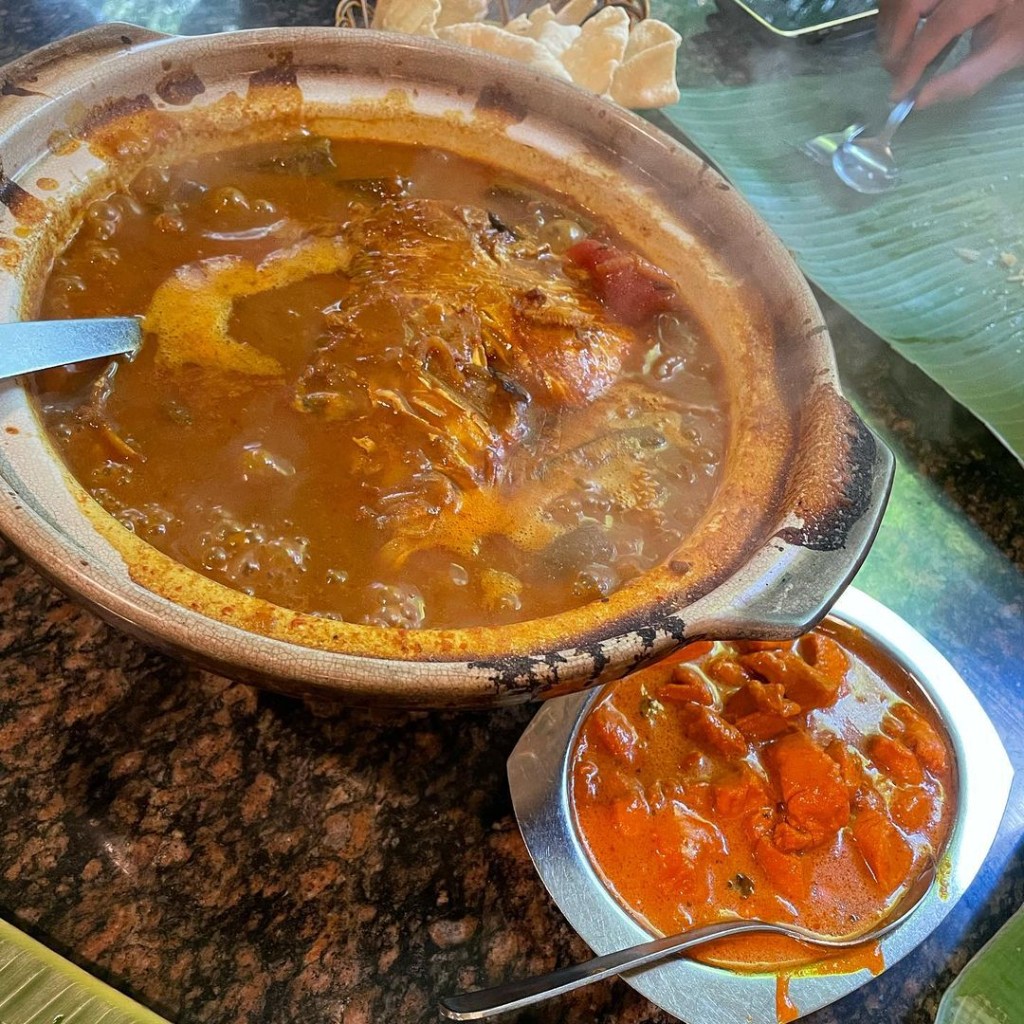15 spots for the best fish head curry in Singapore

- 1. Zai Shun Curry Fish Head
- 2. Ocean Curry Fish Head
- 3. Muthu’s Curry
- 4. Yu Cun Curry Fish Head
- 5. Jurong West Claypot Curry Fish Head
- 6. Jia Yi Curry Fish Head Eatery
- 7. Chye Lye Curry Fish Head Restaurant
- 8. The Banana Leaf Apolo
- 9. Yun Seafood Fishhead Steamboat
- 10. West Co’z Cafe
- 11. Samy’s Curry Restaurant
- 12. Karu’s Indian Banana Leaf Restaurant
- 13. Xin Yuan Ji
- 14. Ivins Peranakan Restaurant
- 15. The Curry Wok
The fish head curry is an iconic dish that’s unique to Singapore — its origins a symbol of the country’s rich cultural melting pot.
Created in the 1940s in an Indian restaurant, the owner, who was from the state of Kerala, decided to cater to the tastebuds of its Chinese customers by combining Indian curry with fish head, a Chinese favourite. The Singapore curry fish head was born.
This dish is now well-loved by the many ethnic and cultural communities in Singapore, such as Indian, Chinese, Malay and Peranakan, with many restaurants even coming up with their own spin on it by varying the spices and ingredients used.
If you’re a spice lover, there’s really nothing more comforting and enticing than a piping, hot bowl of bright turmeric-coloured broth, seasoned with a special mix of fragrant spices and cooked with assorted vegetables alongside the star of the dish — a generous fish head, bubbling away in an earthen claypot.
Today, fish head curry is found all over Singapore, from little hidden gems in our heartlands to larger well-known restaurants. With options all over our island, I thought it would be good to create a list of the best curry fish head near me (and you).
Without further ado, here’s where you can find 15 of the best curry fish heads in Singapore.
1. Zai Shun Curry Fish Head
253 Jurong East Street 24, 01-205
Open: Thursday to Tuesday (7am to 3pm)

Why visit? Zai Shun Curry Fish Head is a Michelin Bib Gourmand stall selling chap chye png (economic mixed vegetable rice) and zi char, located at a coffee shop within a neighbourhood estate in the west. Here, you can find restaurant standard fare at affordable prices.
Fresh fish is brought in daily; the owner Ong Cheng Kee has been in the business of cooking and selling fish for more than 40 years, and hence ensures that his fish supply is of the freshest quality.
As such, you can expect extremely fresh fish head cooked in a fragrant and tangy assam curry broth here. For this dish, Zai Shun uses wild caught red snapper that has soft, sweet and tender flesh. Not only is it rich and flavourful, portions are also very generous.
Price range: $$
Crowd favourites: The eatery serves up a great bowl of fish head curry (from S$25), but do note that this is only available after 11am. It is also well known for its steamed fish, which is always steamed to perfection and never overcooked. Fish connoisseurs will love this extra bit — you get the option of choosing the type of fish you’d like to have.
2. Ocean Curry Fish Head
Multiple outlets islandwide
Operating hours vary across stores

Why visit?.Well-known for its Peranakan-inspired curry that comes bubbling in a large claypot, Ocean Curry Fish Head is quite the household name and has been serving fish head curry since 1983. The curry gravy at this popular cai png stall is of a good consistency — not too thin or thick. There’s always a long snaking queue during lunch, so make sure you come early.
Price range: $$
Crowd favourites: Cooked only upon order and served in a claypot, the curry fish head (S$42 for a serving that’s good for three to four persons) here may be on the pricier side but the crowd and queue is testament to its worth. Starring fresh, succulent anggoli (sea bream) meat and accompanied with a generous amount of vegetables such as brinjal, lady’s finger, onion, tomato, and pineapple, it’s a rich and creamy concoction that will have you wanting more (and eating more rice than you intended to).
3. Muthu’s Curry
138 Race Course Road, 01-01
Open: Monday to Sunday (10.30am to 10.30pm)

Why visit? Muthu’s Curry is a Michelin Bib Gourmand restaurant championing South Indian-style fish head curry that was pioneered by its founder back in 1969. The special recipe has now been passed down to the next generation and is a closely guarded secret.
Cooked with its tantalising blend of aromatic spices, chunks of pineapple, lady’s finger and a hint of tamarind, there is a depth of flavour to its curry. For the fish head, there is a choice of red snapper, sea bass or sea bream depending on seasonal availability.
Price range: $$
Crowd favourites: For sure, it would be its rich and flavourful fish head curry (S$35), which has an amazing balance of curry spices. Regardless of your fish selection, you can be assured of a good-sized fish head with succulent, fleshy meat that has absorbed all the flavours of the curry. Prices here may be on the higher side but the superb food, convivial ambience and impeccable service makes up for it.
4. Yu Cun Curry Fish Head
147 Upper Paya Lebar Road
Open: Monday to Sunday (11.30am to 10pm)

Why visit? Yu Cun Curry Fish Head in Paya Lebar is a huge favourite among diners here when it comes to fish head curry. You can tell from the long lines during peak hours! We hear the owner used to have experience running zi char stalls, and eventually decided to open a full-service restaurant with his children. Known for being a family-friendly spot, you can’t miss the restaurant’s prominent sign when you drive along Upper Paya Lebar Road.
The curry here is really fragrant, boasting a lovely balance between being rich and creamy, yet not being overly heavy on the palate. The spice level is perfect for those who enjoy a kick of heat to their taste buds, but thankfully for those who are not fans of spice, the eatery also offers a less spicy version.
Price range: $$
Crowd favourites: The claypot curry fish head (S$36) is more similar to Indian-styled curry, while the claypot nyonya fish head (S$38) is a touch sour and tangy. Between the two, we’d go for the former, which has bolder and deeper flavours. Regardless which you pick, the fish head for both dishes are fleshy and fresh, and the dish comes with an array of other ingredients such as lady’s fingers, long beans, brinjal, beancurd skin and tau pok that has soaked up the curry gravy delightfully.
5. Jurong West Claypot Curry Fish Head
496 Jurong West Street 41
Open: Monday to Sunday (12pm to 2pm, 5pm to 9pm)

Why visit? Jurong West Claypot Curry Fish Head has been reliably dishing out its fish head curry for more than 40 years, so you can be assured of its quality. The fish head curry served here is a Chinese-styled assam curry, which has a unique pineapple tang, thanks to the generous pineapple chunks that it uses in its broth. The consistency of the curry here is lighter, yet it does not fall behind in terms of its flavours.
The end-result is a zesty and appetising curry that tantalises your tastebuds with its citrusy notes. Along with the sweetness from the fish meat, the harmonious balance of sweet and sour elements will leave you craving another mouthful. Definitely worth a trek to the west.
Price range: $$
Crowd favourite: If you enjoy sour assam curry, or prefer something not too heavy, you should definitely give this Jurong West curry fish head (from S$22) a try. Regulars say they love how its creamy broth gives just the right amount of piquancy and tartness — in fact, some say they could drink it up with a straw!
6. Jia Yi Curry Fish Head Eatery
Upper Serangoon Shopping Centre, 03-18, 756 Upper Serangoon Road
Open: Monday to Saturday (7.30am to 3.30pm)

Why visit? Jia Yi Curry Fish Head Eatery is a small hidden gem on the third floor of an old shopping centre in Kovan selling a mix of chap chye png (economic mixed vegetable rice) and zi char dishes. Specialising in local claypot delights, its assam curry fish head is a signature and has everything that a good fish head curry needs to have. Bonus: The location and storefront bring about a sense of nostalgia and old-school vibes. Paired with its rustic and comforting bowl of curry, this will certainly warm both heart and soul.
Price range: $$
Crowd favourites: The assam curry fish head (from S$25) tastes excellent and comes with a beautifully cooked fish head and a generous portion of vegetables — offering good value. Its vinegar pork knuckle (S$7) is also worth a try. Do note that it only operates in the day time, closing by 3.30pm each day.
7. Chye Lye Curry Fish Head Restaurant
579B Sembawang Place
Open: Monday to Sunday (11.30am to 8pm)

Why visit? Chye Lye Curry Fish Head Restaurant used to operate at Jalan Legundi, but after facing lease issues, decided to take the path less trodden. It moved its business to a home-based setting, which means diners can now enjoy restaurant-quality food and service a la private-dining style at its residence — located a short distance away from its previous location. Talk about a unique dining experience!
Price range: $$
Crowd favourite: As its name suggests, its curry fish head (S$32 for medium, S$37 for large) is one of its specialties. It has a slight assam taste to it that is not overpowering, and the result is a delightfully appetising bowl of curry that you will definitely enjoy alongside other homemade fare. The fish head is fresh, and has a good amount of meat to soak up the mouthwatering curry gravy.
You can have it via takeaway or call in for a private booking — do book at least a day in advance to avoid being disappointed.
8. The Banana Leaf Apolo
Multiple outlets islandwide
Operating hours vary across stores

Why visit? The Banana Leaf Apolo is famed for serving its food on banana leaves, a tradition that has its roots in India. Why? Banana leaves are strong in antioxidants, releasing a sweet and earthy aroma used in cooking or when hot food is placed on it. This tradition has continued till this day, since the halal-certified restaurant was founded back in 1974. Its authentic Indian food is full of depth, and is popular among tourists and locals alike.
Price range: $$
Crowd favourites: Its signature is, of course, the Apolo fish head curry (from S$30.50 for small). A red snapper head is cooked in a tantalising blend of fragrant spices, incorporating pineapple chunks, tomatoes, tamarind and a medley of vegetables, resulting in a symphony of flavours with every bite. The spice level of the curry here is not for the faint-hearted, but it’s something that spice lovers will certainly enjoy.
The dish will go well with its free-flow briyani or white rice (S$3.90 per person) and crunchy pappadum.
9. Yun Seafood Fishhead Steamboat
632 Ang Mo Kio Avenue 4, 01-948
Open: Monday to Sunday (11am to 9.30pm)

Why visit? Tucked away in an unassuming corner of a coffee shop just a short distance from Yio Chu Kang MRT station, this Chinese Teochew-style zi char place is known for both its fish head curry as well as fish head steamboat. Yun Seafood Fishhead Steamboat takes pride in the freshness of the fish that it cooks up and serves, alongside a wide selection of other dishes. Although it’s lesser-known than the other big names on this list, it does have its faithful regulars A great option for a casual, no-frills gathering for comfort food.
Price range: $$
Crowd favourites: Pssst, we know this is a list of some of the best fish head curry in Singapore, but here’s a little secret. While the curry fish head (quoted at market price) here certainly fits the bill, boasting fresh tender fish in a rich broth, you may also want to try out its fish head steamboat (from S$35) or the fish head/sliced fish soup (from S$8). We’ve heard that its fish soup is quite the winner!
10. West Co’z Cafe
West Coast Plaza, 02-23, 154 West Coast Road
Open: Monday to Sunday (11.30am to 9:30pm)
35 Junction 10, 01-34, 1 Woodlands Road
Open: Monday to Sunday (11.30am to 9:30pm)

Why visit? West Co’z Cafe is a Muslim-owned, halal-certified restaurant selling top-notch zi char dishes. Its popularity is apparent from the crowd, especially during peak hours. Its signature dish is its curry fish head, boasting a generous amount of coconut milk that presents a thickness and creaminess that sets it apart from others. Chock-full of ingredients such as long beans, brinjal, tau pok slices and a big and fresh fish head, it’s no wonder that people head down to this place specially in search for this curry dish.
Price range: $$
Crowd favourites: The favourite here is its curry fish head (S$26), but the eatery also does a mean pot of the tangier assam fish head (S$26). For those who love fish and curry but not so much the fish head, the good news is you can also opt for either its curry fish tail or assam fish tail (S$28).
11. Samy’s Curry Restaurant
25 Dempsey Road
Open: Wednesday to Monday (11am to 3pm, 6pm to 10pm)

Why visit? Hailing all the way back to the 1960s, Samy’s Curry Restaurant is one of the oldest and most established Indian restaurants in Singapore, selling a mix of North and South Indian delicacies. It also has the honour of being known as one of the first places to ever serve fish head curry! It’s consistently listed as one of the top spots to have the best Indian fare, so this spot is not to be missed.
Price range: $$
Crowd favourites: Its bestseller is Samy’s fish head curry (from S$22). The Indian-styled curry is cooked with a huge variety of herbs and spices, along with its special chilli powder that is sure to spice up your taste buds.
In line with tradition, this is served bubbling hot in a claypot with a red snapper head whose meat is firm and fresh. Pair this with its free-flow briyani rice (S$4.50 per person) that’s served on fresh banana leaf; it also comes with unlimited refills of side dishes, such as pumpkin curry and cucumber salad. A meal you will wholeheartedly enjoy.
12. Karu’s Indian Banana Leaf Restaurant
808/810 Upper Bukit Timah Road
Open: Tuesday to Sunday (11.30am to 8.30pm)

Why visit? There’s just something about the aromatics of Indian spices, and they are definitely utilised to their full potential here at Karu’s Indian Banana Leaf Restaurant. This is where you can find authentic Indian cuisine, and as its name suggests, you get to enjoy all these eating off sheets of banana leaf.
Established in 1993, the self-proclaimed ‘fish head king’ serves a power-packed fish head curry that’s an intense bowl of flavours. The restaurant also offers free-flow briyani or white rice, papadum and vegetables.
Price range: $$
Crowd favourites: Its fish head curry (from S$30) is cooked traditionally with quality spices sourced from India that does not overpower the fish meat. It has a signature look — it’s always adorned with half a tomato that has been cooked till it has softened beautifully. Needless to say, the dish has earned itself a loyal following.
13. Xin Yuan Ji
31 Tan Quee Lan Street, 01-01
Open: Monday to Sunday (11.30am to 11pm)

Why visit? Xin Yuan Ji is an eatery that has actually gained a large following for its fish head steamboat and fish soup, which are its star dishes. However, its assam curry fish head deserves a mention as well. Cooked in a claypot and served piping hot, the curry is thick, fragrant and aromatic. Matched with a sea bream head and a variety of vegetables, this is a comforting and soul-warming dish.
Price range: $$
Crowd favourites: As mentioned, while its fish soup is a beloved and affordable dish to be had, especially on a chilly day, its assam curry fish head (SS28.80) is also worth a try. Tangy, with just the right amount of heat, it goes well with a warm bowl of rice. Who says fish soup and fish head curry can’t go together?
14. Ivins Peranakan Restaurant
21 Binjai Park
Open: Friday to Wednesday (11am to 3pm, 5pm to 9pm)
Heartland Mall, 02-20/21, 205 Hougang Street 21
Open: Monday to Sunday (11am to 3pm, 5pm to 9pm)

Why visit? If you are craving a good nyonya or assam fish head curry, this Peranakan restaurant is the place to satisfy it. Ivins Peranakan Restaurant serves up a wide range of homestyle Peranakan fare with authentic flavours, at an affordable price point. Everything here is made from scratch, with its own blend of herbs and spices. True to the style of cooking, its fish head curry dishes pack a punch with a depth of flavours, pairing beautifully with white rice or coconut rice.
Price range: $$
Crowd favourites: At Ivins, there is the option of the nyonya curry fish head or garam assam fish head (S$27 at the Binjai outlet / S$30 at the Kovan outlet). Both come in a hearty serving that is good to share among three to four people.
Comprising half a snapper fish head served with a mix of lady’s fingers and brinjal cooked to melt-in-your-mouth perfection, the main difference between the two dishes is that the nyonya curry fish head is doused in a spicy coconut curry while the garam assam fish head is cooked in a spicy tamarind gravy.
15. The Curry Wok
Coronation Arcade, 01-04, 5 Coronation Road
Open: Wednesday to Monday (11am to 9pm)

Why visit? The Curry Wok is a small but cozy family-run eatery that has been at the same location for years. Whipping up delish Teochew nyonya food, its offerings are reminiscent of a delicious home-styled meal. The curry fish head is prepared using red snapper delivered fresh from the market daily, and put into the wok for steaming only when an order has been made.
Price range: $$
Crowd favourites: If you are a fish head lover, the curry fish head (from S$27) will be irresistible. Accompanying the generous serving of tender fish meat are vegetables such as lady’s fingers, tomatoes and brinjal, all coated with a layer of savoury, umami curry gravy. The rich curry is not only a treat for your taste buds, it’ll make you feel like it’s comfort food cooked by your grandmother.
For more food options, check out our thoughts on the best nasi lemak in Singapore and the new Martin’s Kitchen along Zion Road.
Ocean Curry Fish Head, Muthu’s Curry, Yu Cun Curry Fish Head, The Banana Leaf Apolo, Yun Seafood Fishhead Steamboat, West Co’z Cafe, Xin Yuan Ji, Ivins Peranakan Restaurant, and The Curry Wok are on the GrabFood Delivery Service and offer free delivery (up to S$3 off) with GrabUnlimited.
Check out amazing deals on the GrabFood Dine-in service.
Alternatively, book a ride to these fish head curries in Singapore.







